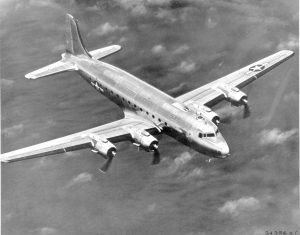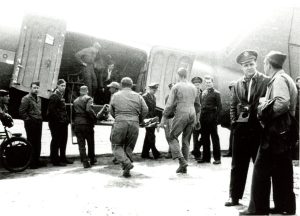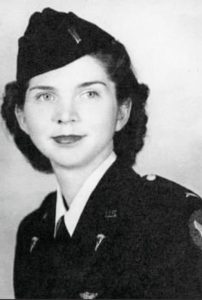The Ninth in a series of Blogs about the 31 Medical Air Evacuation
Transport Squadrons activated during WW2
to provide inflight nursing care to sick and wounded soldiers,
tended by Army flight nurses and enlisted technicians.
The focus is on the flight nurses.
The 801 MAETS Arrives in the Pacific
Activated November 1942
When the 801 MAETS left Bowman Field (advance echelon with no flight nurses departed on 28 December 1942; the rest of the squadron, on 22 January 1943), it was not the first MAETS to embark on its first duty assignment – the 802 MAETS had departed Bowman Field on Christmas Day 1942. But the 801 was the first MAETS to set foot on overseas soil when it arrived at New Caledonia 750 miles east of Australia on 12 February 1943; the 802 MAETS arrived in Oran, Algeria in North Africa on 21 February 1943.
The 801 MAETS set up their first camp at Tontouta near the airfield on New Caledonia, and the first flight nurse flew into Guadalcanal on 1 March 1943, after which the flight nurses flew into the island on a regular basis.
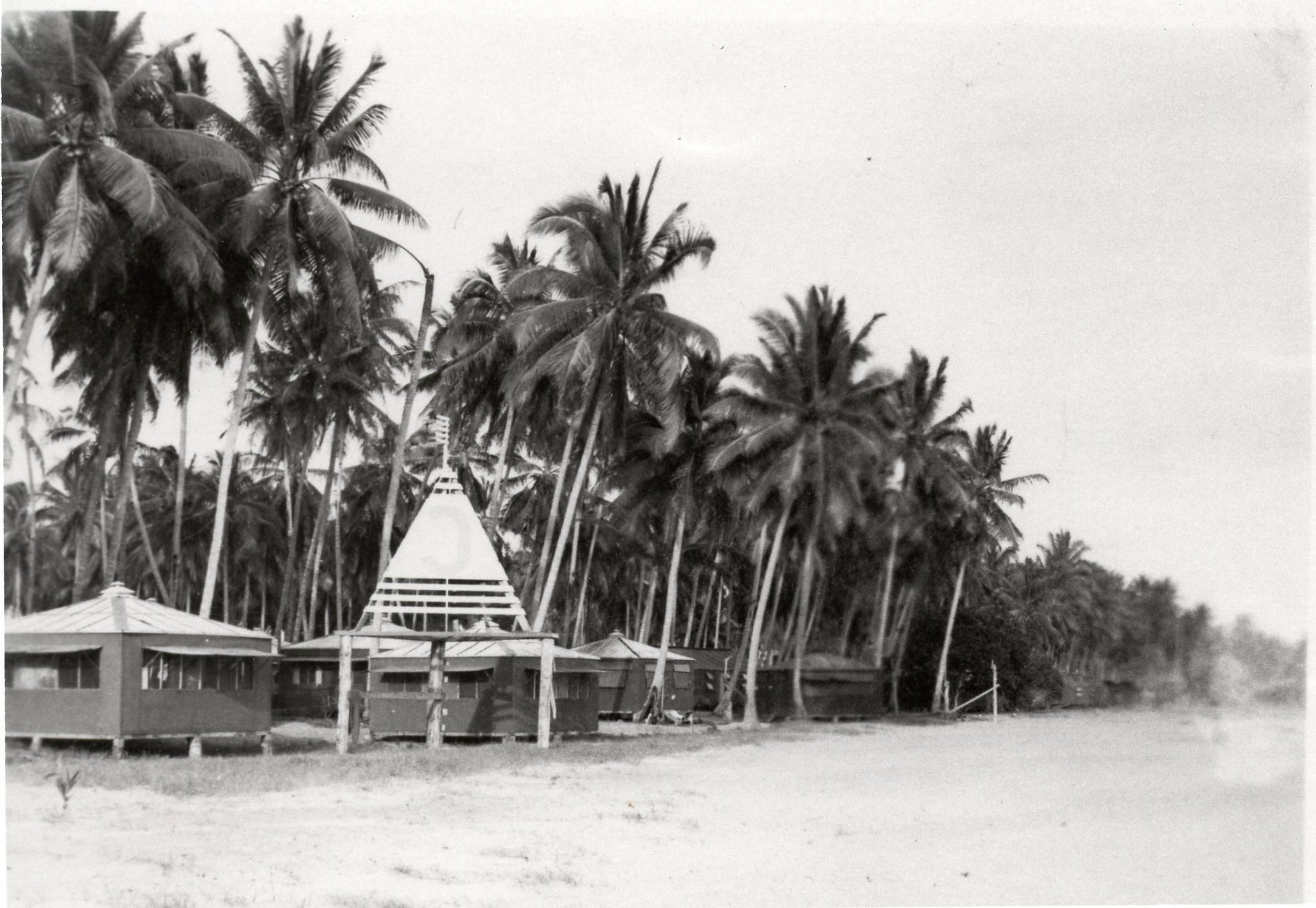
Flight Nurses’ Area, Guadalcanal, July 1944
(Author’s Collection)
When the 801 MAETS commander, flight surgeon Charles Mixter, assessed the situation shortly after arriving in the South Pacific, he identified 4 issues of concern regarding air evacuation activities, 2 of which affected the flight nurses directly:
The vast distances between bases on islands spread over such an immense area of the Pacific; Guadalcanal, for instance, was almost 1,000 miles from the 801 MAETS base camp.
The isolated nature of the theater of combat far from civilization, usually in dense jungle terrain, with airfields often nowhere near the front lines and connected only by poor jungle trails at best.
The unpredictable weather that pilots encountered during flights requiring either an ascent to higher altitude to fly over it or a detour of 400 or more miles to get around it.
The placement of an AAF unit under Navy control in the Medical Section of the South Pacific Combat Air Transport Command (SCAT) that limited the efficiency with which the air evacuation squadron could function. 1
Both the distances of airfields at which patients waited for air evacuation and the Navy policy restricting flight nurses from flying to those airfields impacted the flight nurses’ work. The 801 MAETS squadron history details the duties of the SCAT medical personnel, which gives a good idea of the many facets required for a successful air evacuation mission outside the actual airborne environment. Many are general requirements not limited to air evacuation in the South Pacific or to SCAT:
Liaison work between hospitals and SCAT Medical Section
Equipping planes with medical supplies, food, and water
Care and transfer of patients on the field before takeoff and landing
Proper distribution and return of litters and blankets
Spraying the aircraft for mosquito control
Record keeping, including statistics
Scheduling of personnel on planes
Liaison work with SCAT Operations 2
Lack of coordination often resulted in dry runs when medical personnel arrived at an airfield and discovered no patients to be evacuated – a situation common in the European Theater of Operations as well. The 801 MAETS reports identified 2 reasons: Patients were assigned lower points than other passengers – that is, given lower priority – for air travel; and they often were transported on ships that had brought cargo and personnel to an island rather than be held for the next air evacuation flight. In an active combat area, dry runs could expose air crews – air evacuation personnel included – to needless risks in advanced areas before adequate security and air coverage were achieved.
But more galling to the 801 MAETS was the difficulty obtaining permission for flight nurses to fly into Guadalcanal. On that island as on any other where patients were onloaded or offloaded for air evacuation, adequate quarters and toilet facilities were needed for the flight nurses in case they needed to remain overnight. And SCAT, whose personnel often gave preference to enlisted technicians rather than flight nurses as medical attendants, needed to be convinced that the flight nurses were essential to a successful air evacuation program. For instance:
In August 1943, flight nurses made over 100 flights into Guadalcanal but evacuated patients on only 37 of them. 3
The MAES evacuated about 12,745 patients between the first of March, when the squadron was fully operational with flight nurses, until the end of June 1943, but only 3,864 of these patients were attended by flight nurses. 4
The 801 MAES historian complained about the underuse of the squadron’s flight nurses. Because of SCAT’s operational setup, it was
impossible to use the nurses to the fullest advantage … However, if nurses are not allowed to evacuate patients from forward active areas, their training and skill will be wasted on ambulatory patients being evacuated from the rear areas, who hardly need medical attention at all. 5
The use of flight nurses for air evacuation “is feasible and practical”, the report continued. There should be no contradiction to their use in active zones of combat, with adequate security provided. The reasoning was sound: Flight nurses and enlisted technicians flying separately, rather than as teams, could evacuate twice as many patients. 6 MAETS policy was to assign the most serious cases to planes attended by a flight nurse and the less serious ones to planes attended by an enlisted technician. “These nurses have won the respect and admiration of all with whom they have come in contact, and at no time have there been any untoward incidents, at any of the bases, which, would preclude the presence of women in these areas … All nurses of this unit desire such duty,” the historian concluded, adding, “They have done their duties cheerfully and w[e]ll, their only complaint at the present time being that they have not been given a sufficient percentage of the patients to care for.” 7 Once restrictions by higher authority were lifted and adequate facilities installed, the 801 MAETS was given permission for its flight nurses to stay overnight at Guadalcanal and fly to where they were needed in the combat zone. (SCAT was officially disbanded in July 1944.)
Flying was hazardous, and in their first 6 months squadron members had already been subjected to bombings and attacks while airborne and narrowly missed crash landings due to engine fires, engines failures, and low fuel in bad weather. 8 One such flight occurred on 27 April 1943 when Lieutenant Dorothy Shikowski was returning from an air evacuation mission as a passenger on a C–47 that was transporting a 1600–pound airplane engine as cargo. When bad weather prevented the plane from landing at Tontouta, its destination, the pilot was forced to make a water landing. He instructed passengers and crew to remain aft of the cargo engine in case it shifted forward on impact with the water, but one crew member disregarded the instructions. Shikowski jeopardized her own safety as she rushed forward to instruct him to move to the rear of the plane. The plane hit the water before she could reach him. Both Shikowski and the crew member were pinned in when the engine lurched forward. The crew member was killed. The crew freed Shikowski, and, despite back and leg injuries, she then helped load the life rafts with medical supplies, rations, and water and helped evacuate the other passengers before the plane sank. Shikowski was awarded the Air Medal in recognition of her heroic action. 9
The 801 MAETS flight surgeons monitored the health of the flight nurses and enlisted technicians closely for any signs of physical fatigue and mental exhaustion associated with their flying activity, stressing that air evacuation personnel should be treated like other air crew members, since they were exposed to the same hardships and strains as other crew members and recommended that flight nurses be replaced and rotated back to the US after a year overseas.
In October 1943 the 801 MAETS moved to Espiritu Santos in the New Hebrides in support of the Campaign of the Northern Solomons; the 801 MAETS personnel were flying regularly into the combat zone northwest of the Russell Islands. In March through May 1944 the last of the original flight nurse cadre of the 801 MAETS departed, and their replacements arrived at Guadalcanal where the 801 MAETS was relocating. In May, the 801 MAETS lost its first flight nurse when the plane on which Eloise Richardson was traveling to pick up patients departed Bougainville and disappeared without trace or communication. Whether the plane encountered hazardous weather or anti-aircraft fire is unknown. Richardson and the rest of the crew were declared Missing in Action.
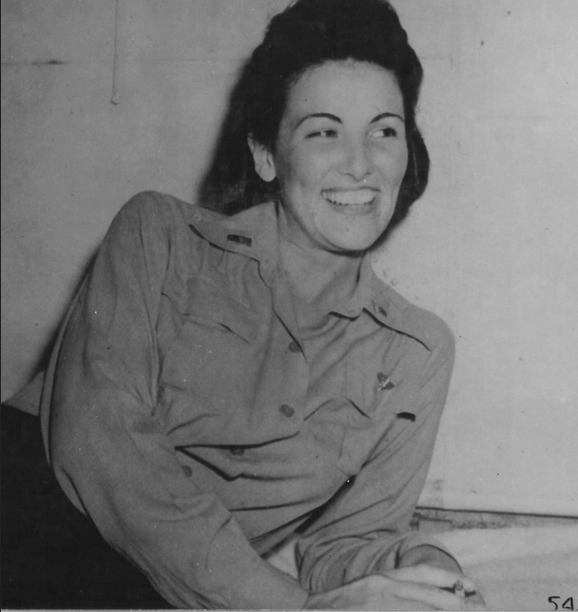
Eloise Richardson, circa 1 May 1944,
Guadalcanal (AFHRA)
Flight surgeon Wilbur A. Smith, who wrote the historical reports as commander of the 801 MAETS, inserted dry humor into what could be simply by-the-book documents when he described the ongoing training in which all MAETS personnel participated overseas:
The disturbing influence this month to the personnel of this Squadron was the introduction of a training program that reached everyone according to his or her duties. All personnel were reinstructed in the Articles of War, Military Courtesy, Chemical Warfare and Defense against it, the Art of Staying well in the Tropics, and Military Security. The flying personnel had added such subjects as High Altitude Physiology, Jungle Survival, First Aid to the Injured, and Emergency Treatments likely to be needed during flight. The nurses had one special session on problems believed peculiar to them. The officers are busy tending to the details of learning how a squadron is administered by actually doing the work. Such a vigorous program is quite debilitating upon the personnel so we have noticed a large increase in the number who needed rest leave in Sydney. At least then if they go to the cinema two nights a week, they will be able to see subjects of their own choosing. 10
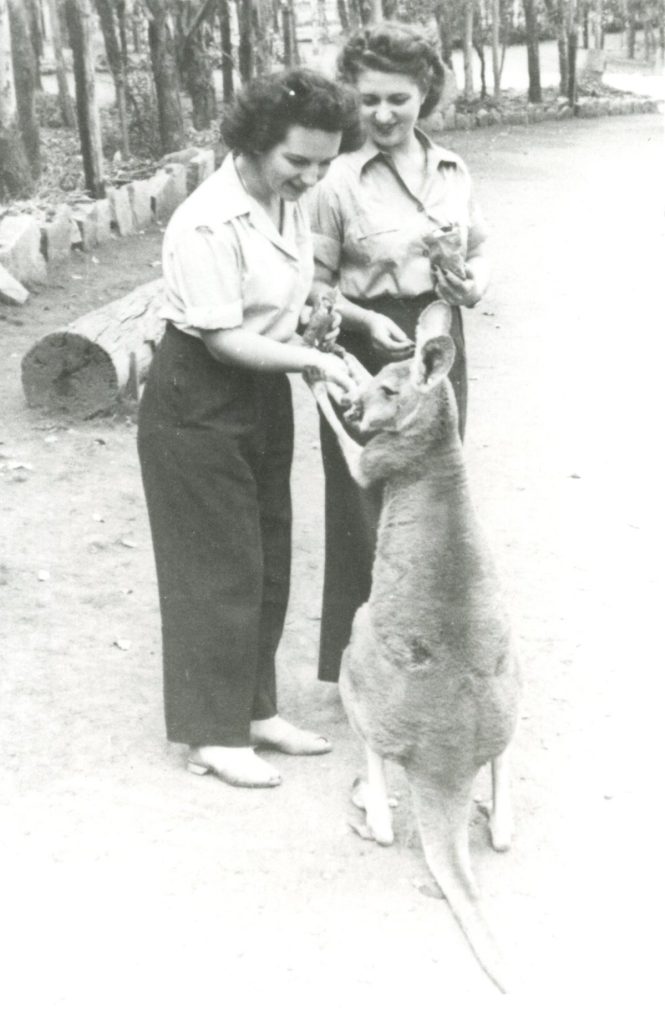
Helena Ilic (left) and Nancy Preston on R&R
in Australia (Author’s Collection)
Smith ended his report, “Now the best has been saved to last. Lts. Preston and Endres have furnished a female’s impression of the place and work.” [Exhibit H] 11 In their ‘expose of the very personal lives of the girls in our group … to enumerate many of the “what’s-gone-on-behind-the-CO’s-desk”, the 2 flight nurses share their trials and tribulations on and off duty in a humorous vein regarding living accommodations, uniforms, flights, and social life. “We are proud of our organization; we are proud of the fact that it is the first child of air evacuation, that it functions quietly and without pomp, and that it has a ‘something’ that makes us want to stay with it,” Preston and Endres begin. 12
The flight nurses moved with the 801 MAETS to Biak, an island in the Netherlands East Indies off the northern coast of Papua, New Guinea in October 1944 in support of the Campaign for the Liberation Philippines. Here they were reinforced by nurses of the 804 MAETS and 820 MAETS who with their squadrons had arrived in the Pacific in June 1943 and March 1944, respectively. The 3 MAETS worked together as they leap-frogged toward the Philippines. In October 1944 the 801 MAES sent a detachment minus its flight nurses to Leyte to coordinate air evacuation activities in the Philippines; in January 1945 the 801 MAES flight nurses began flying into Mindoro, an island in the Philippines. Based at Biak, with a detachment at Morotai, from January through March 1945, the 801 MAES performed most of the patient air evacuations from Leyte to Biak. The men of the 801 MAETS relocated to Leyte in the Philippines in March, where the flight nurses eventually joined them.
When in August the 804 MAES and 820 MAES, also based in the Philippines, were ordered to Okinawa, the 801 MAES assumed responsibility for all air evacuation in the Philippines. The latest round of assignments led 801 MAES commander Paul Cronenwett to grouse: “It’s the same old story – this squadron has once again been delegated the rear area evacuation duties. Our compatriots in the field of air evacuation in this theater have been assigned the long dreamed of plum of evacuation, that of flying into the Tokyo area.” 13 As Preston and Andres explained, “To be the first girl to land on a newly acquired island is the ardent wish of every member of our crew – and to evacuate the largest number of patients is her sincere hope. No one wishes to ‘goof off’ from her job for it is only the added excitement of having contact with patients from the real frontlines that keeps our work from being hum-drum.” 14
Flight surgeon Russell Ameter had noted at the end of 1944 when the MAETS was on Biak that the flight nurses’ physical health was good and that their morale correlated with how much they flew – “the more they fly and are kept busy, the better their morale”. They had flown less, because flights were divided among the 3 MAETS working together and because higher authorities considered flights into Leyte too dangerous for the flight nurses. The irony of a correlation between flight nurse satisfaction and number of battlefield casualties was not lost on Clara Morrey, a flight nurse in the 802 MAETS in the Mediterranean: “The morale of the squadron was always good when we were busy – a sad commentary when you realize that was the time when our soldiers were being killed and injured in great numbers. Somehow we felt that we were helping when we were needed most.” 15
In September 1945 when the 801 MAETS was still in the Philippines after their colleagues had moved closer to Japan, Cronenwett helped keep up the nurses’ morale by granting 3–day trips to Manila. “It’s a wise man who recognizes the value of a shampoo or new hair-do or a shopping tour for our feminine members. … I might add that once in a while it’s a visit to see a boyfriend who is on his way home. Needless to say all these small liberties pay dividends.” 16
For more about the 801 MAES, see Beyond the Call of Duty: Army Flight Nursing in World War II, Chapter 9. For more about flight nurses in the 801 MAES, see Blogs posted for
Adele Edmonds Daley 16 Oct 2016 and 20 Feb 2021
Ivalee (Lee) Holtz 30 Aug 2015 and 12 Jan 2020
Helena Ilic Tynan 1 Nov 2015 and 14 Mar 2020
Lucy Wilson 8 Aug 2015 and 20 Dec 2019
Audio recordings of these my interviews with these flight nurses are available at:
Adele Daley: https://www.iwm.org.uk/collections/item/object/80011342
Ivalee Holtz: https://www.iwm.org.uk/collections/item/object/80011350
Helena Tynan: https://www.iwm.org.uk/collections/item/object/80011359
Notes
- “Report of the Activities of the 801st Medical Air Evacuation Transport Squadron”, 26 Sep 1943, 801 MAES. [AFHRA MED–801–HI]
- “Personnel: Flight Nurses”, 801 MAETS, 49. [AFHRA MED–801–HI]
- “Summary of Activities”, 801 MAETS, 30. [AFHRA MED–801–HI]
- Ibid.
- “Physical and Mental Effects on Crew Members to Their Task of Flying Under All Conditions in This Area”, 801 MAETS, 25. [AFHRA MED–801–HI]; “Personnel: Flight Nurses”, 801 MAETS, 49.
- Ibid.
- “Personnel: Flight Nurses”, 801 MAETS, 49.
- “Chronological List of Unusual Occurrences,” 801 MAETS, 8. [AFHRA MED–801–HI]
- “General Orders No. 139 Extract, 1. Award of the Air Medal”, Headquarters USAFISPA, APO #502, 2 Jun 1943. [AFHRA MED–801–HI]; “Bowman Trainee First Woman Decorated In South Pacific”, Louisville Courier Journal, 22 Jun 1943.
- Wilbur A. Smith, “Historical Data: 1 August 1944 to 31 August 1944”, 801 MAES, 1 Sep 1944), 4. [AFHRA MED–801–HI]
- Ibid., 5.
- Nancy L. Preston and Ada M.S. Endres, “The Feminine Side”, 801 MAES, Aug 1944, 1. [AFHRA MED–801–HI]
- Paul H. Cronenwett, “Historical Data: 1 August 1945 to 31 August 1945”, 801 MAES, 5 Sep 45, 4. [AFHRA MED–801–HI]
- Preston and Endres, “The Feminine Side”, 2–3.
- Clara Morrey Murphy, “Air Evacuation – World War II – African–Europ[e]an Theater”, unpublished speech. [AMEDD]
- Russell K. Ameter, “Quarterly Historical Report of Medical Activities, 1 October 1944 to 31 December 1944”, 801 MAES, 31 Dec 1944. [AFHRA MED–801–HI]; Cronenwett, “Historical Data: 1 August 1945 to 31 August 1945”, 5 Sep 1945, 801 MAES, 6.

